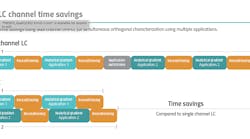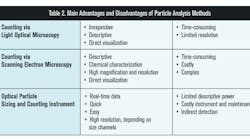Compressed air — the overlooked element of cleanroom specifications
To ensure end-product quality and safety it is necessary for pharmaceutical manufacturers to build quality standards and reliable monitoring plans into their processes. Compressed air systems, while critical to many manufacturing processes and cleanroom environments, are often overlooked in risk management. This is, in part, due to the lack of specific regulations that can leave manufacturers at a loss on how to correctly monitor these systems. One way to provide clarity and reliability to the manufacturing process is to use cleanroom standards for compressed air systems.
Recommendations
The International Society for Pharmaceutical Engineers (ISPE) Good Practice Guide specifies, “in cases where the gas is entering a classified area, it is required to at least meet the room classification limits established for the cleanroom environment” (2016). Additionally, the most recent US FDA Guidance for Industry Sterile Drug Products Produced by Aseptic Processing – Current Good Manufacturing Practice recommends that “compressed gas should be of appropriate purity… and it’s microbiological and particle quality after filtration should be equal to or better than that of the air in the environment into which the gas is introduced.”
Using the guidance of the US FDA and ISPE GPG, pharmaceutical manufacturers can properly evaluate the quality of their processed gases including nitrogen, oxygen, argon, carbon dioxide, and compressed air. Chad Larrabee, Global Product Management Leader of Ingersoll Rand and GPG: Process Gases co-chair, explains that the compressed air used in cleanroom environments should match the quality levels required by that room (2019). This mirrors the recommendations made by the US FDA. By implementing a monitoring plan, pharmaceutical manufacturers can ensure that their compressed air quality maintains the determined levels.
The International Organization for Standardization (ISO) published a standard for compressed air quality that contains 9 parts. This standard, ISO 8573:2010 is commonly used for compressed air applications. Despite this, pharmaceutical manufacturers often favor cleanroom specifications over ISO 8573-1 to conform to their cleanroom facility. It can be useful to translate ISO 8573-1 specifications into cleanroom classifications to facilitate communication with manufacturers and other distributors. The following chart depicts how the two compare and can be used in conjunction to avoid confusion.
Common uses of compressed air
The ISPE Good Practice Guide asserts that a logical method for determining the requirements of a facility’s compressed air quality is to review the role of the gas in the process. Process gases and compressed air are used in a variety of ways depending on the product manufactured. While some facilities use compressed air in direct contact with products to clean, aerate, or move them through the processes, others use process gases in fluid pumps that take products through the production and filling processes. Nitrogen generators or compressed air can be used for packaging or blanketing depending on the result required. Process gases can also be used to spray or coat a product, or as an ingredient of the product itself. The amount and type of contact that products have with compressed air or process gases informs the risks associated and necessary monitoring plans for a system.
Contamination and risks
The ISPE Good Practice Guide recommends a risk based assessment which evaluates what might go wrong, what will probably go wrong, and identifies the potential consequences of these risks (ISPE GPG, 2011). It is important for manufacturers to consider the unique risks for each facility. When compressed air is introduced to the environment, it must also be controlled and monitored as it can have an impact on the cleanroom and products themselves. Therefore, controlling contamination means controlling the total environment (McFadden, 2007).
According to ISO 8573-1 and ISPE, the common contaminants in process gas or compressed air are nonviable particles, water, oil, and microorganisms (viable particles). Each of these contaminants put products and systems at risk and require regular testing.
Cleanroom specifications set guidelines and limits for particle quantities in ambient or environmental air. Most compressed air intakes are located outside of the cleanroom and therefore that air is not monitored or controlled. Compressor systems draw in unfiltered ambient air for the compression process where particles, water, oil, and/or microorganisms can contaminate the final compressed air if proper air treatment is not applied at the point-of-use. In fact, one cubic meter of untreated compressed air can contain close to 200 million dirt particles and other substances (Nexflow, 2018).
Pharmaceutical manufacturers, in particular, who do not employ an oil free air compressor should monitor for hydrocarbon contamination. An excess of oil aerosol can accumulate to eventually form liquid oil. This can cause an immediate system shut down. Hydrocarbons are oily liquids and vapors that can be hazardous to consumers and products. These are regularly found in some cleaning solutions and sometimes in compressed air systems as lubricants. If ingested, hydrocarbons can cause consumer illnesses. Additionally, when the system heats up, lubricants can create oil vapors. Because oil has a low vapor pressure, it is extremely hard to get rid of contamination once it occurs. Many facilities employ an oil-free compressor to avoid contamination, but while the compressor does not add oil to the air stream, this does not completely remove the possibility of an oil contamination since ambient air being ingested into the compressor can contain hydrocarbons such as exhaust fumes. Proper filtration and regular testing are still required because ambient air can contain hydrocarbons such as benzene and toluene, cleaning supplies can release hydrocarbons, and compressor systems can harbor industrial oil.
Water contamination can be detrimental to the longevity of a compressed air system by causing the corrosion of pipes, tubing, and other system functions. Repairs and replacements for water damage are extremely expensive and time consuming. Moisture also provides a suitable breeding ground for microorganisms to grow and flourish. To address this issue, pharmaceutical manufacturers often use desiccant driers to remove moisture from the compressed air, however when regenerated, the process creates desiccant dust, small particles which should be removed with a particulate filter just after the dryer (Larrabee, 2019).
Bacteria, yeast, and mold contamination put end-users and exposed employees at risk. When microorganisms are starving for nutrients, they produce exotoxins. Exotoxins, even in very small amounts, can cause illnesses (like botulism) in consumers. Some bacteria can also produce non-viable products like endotoxins. These secondary metabolites that are very harmful to consumers. Countless products have been recalled due to microbial contamination. Sterile filters are often employed to prevent viable particles from impacting end-products (Larrabee, 2019).
Whether contamination is from non-viable particles, water, oil, or microorganisms, any contamination can induce a shut-down, cause a recall, or require equipment replacement and re-validation. The loss in revenue and product alone can be detrimental to a brand, but the loss of confidence from consumers is even more damaging. Brand reputation is difficult to build, but easy to lose. Because of these damaging consequences, pharmaceutical manufacturers must strive to implement quality processes into their systems, prevent contamination from occurring in the future, and regularly test their compressed air systems.
Controlling and monitoring
According to Chad Larrabee, Global Product Management Leader of Ingersoll Rand, predictability and repeatability are the most important factors of any quality plan in pharmaceutical manufacturing. Because of this, it is critical to design a monitoring and sampling plan that allows facilities to catch potential issues before damaging any products (Larrabee, 2019).
Sampling frequency and locations will depend heavily on the individual risk assessment created by the facility. Some manufacturers choose to test quarterly to account for seasonal changes, while others choose to test before and after maintenance is performed. This ensures that no contamination was caused during maintenance either from personnel, cleaning materials, or systemic changes. Annual testing is an option for manufacturers, however this does not provide adequate data for trend analysis and is representative of the system only at the time of sampling.
The ISPE Good Practice Guide provides the following chart as a helpful recommendation of sampling plans per contaminant:
When working with an accredited laboratory, sampling and testing compressed air can be a simple process. Depending on classes required, different equipment can be purchased or rented. It’s important to ensure that your laboratory can meet your individual needs and that they report the analyses in a way that meets the require cleanroom classifications. Trace Analytics, LLC can test to a wide variety of specifications including ISO 8573-1, ISPE Good Practice Guide, Cleanroom Classifications and custom specifications. Ingersoll Rand provides oil free compressed air systems certified by TUV for class 0 according to ISO 8573-1:2010 meaning the compressor adds no oil to the air stream.
To provide reliable compressed air and gas quality, many pharmaceutical manufacturers choose to apply cleanroom standards to their process air. This is achieved by analyzing facility risks, reviewing the role of air or gas in the process, understanding the major contaminants and the risks they pose, and implementing a monitoring plan.
Jenny Palkowitsh the marketing manager at Trace Analytics. Trace Analytics is an A2LA accredited laboratory specializing in compressed air and gas testing for food and beverage manufacturing facilities. Using ISO 8573 sampling and analytical methods, their laboratory tests for particles (0.5-5 microns), water, oil aerosol, oil vapor, and microbial contaminants found in compressed air. For over 29 years, they’ve upheld the highest industry standards of health and safety, delivering uncompromising quality worldwide in accordance with ISO, SQF, BRC, and FDA requirements.
Chad Larrabee is Global Product Management Leader at Ingersoll Rand. Larrabee has more than 25 years of experience working in the compressed air industry and serves as the chairman of the education committee for the Compressed Air and Gas Institute (CAGI). He is the former co-chair of ISPE’s Critical Utilities Community of Practice and led a team of volunteers and contributed as editor in the development of the Good Practice Guide for Process Gases – a publication by the International Society of Pharmaceutical Engineers (ISPE).







